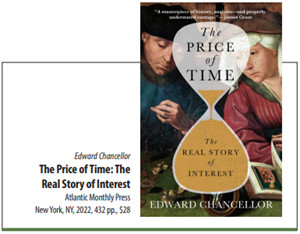Financial writing loves superlatives like “four-week high” and “most in a year.”

The financial journalist and author of Devil Take the Hindmost: A History of Financial Speculation has produced another deep historical dive with his exhaustively researched history of interest rates.
Low rates star as villain. Central bankers obsessively pursued inflation targets, blinded to the harms, and in addressing problems like the 2008 crisis and Europe’s sovereign debt woes, the consequences “were never properly considered or resolved.” Chancellor’s examples, spanning eras and countries, blame ultralow rates for hurting growth, productivity, savings, and investment. They keep zombie firms alive, fuel inequality, inflate bubbles, and undermine financial stability.
He criticizes Federal Reserve policy for low rates dating back nearly to its 1913 founding. The Fed’s “suppressing economic volatility encouraged the build-up of financial leverage” as easy money ignited the 2008 financial crisis, the author says. Chancellor approvingly quotes financial journalist James Grant, founder of Grant’s Interest Rate Observer, as saying that the Fed’s “functional dual mandate has become that of arsonist and fireman.”
Among examples of “malinvestments induced by ultra-low interest rates,” Chancellor highlights price-fixing cartels, citing research that shows they’re influenced most by interest rates. Low rates led to overvalued start-ups, such as the $9 billion peak valuation of Theranos, the fraudulent medical testing start-up founded by Elizabeth Holmes. Another example is the Arab Spring, which Chancellor sees as originating with low US interest rates that drove capital flows to emerging market economies and sent food prices soaring. And there’s crypto, a mania “born of monetary conditions” as much as technology: “The debasement of currencies by central banks meant a new type of money was needed.”
Amid monetary anesthetization, Chancellor sees concern for capitalism, liberalism, and democracy itself resurfacing. Central banks are manipulating “the most important price in a market-based economy” and the beating heart of capitalism.
Without the necessary pulse from borrowing costs, future income can’t be valued, capital can’t be properly allocated, and too little is saved, according to the author. An unruly adverse feedback loop looms. If this continues, “state investment would have to replace private investment and central banks would have to replace commercial banks as the major providers of credit,” Chancellor concludes. “Without interest to regulate financial behavior, an inherently unstable financial system would require endless new regulations.”
The Hebrew word for interest, neschek, “derives etymologically from the bite of a serpent,” Chancellor’s opening notes. His closing posits that “no bite” is even worse.
Opinions expressed in articles and other materials are those of the authors; they do not necessarily reflect IMF policy.








